Ghost stories are a natural fit for the theatre. Spectres and superstitions are deeply woven into its history. You might remember the tradition of “ghost lights” to keep spirits at bay. Melbourne even has its own theatre ghost,Federici – an opera singer who died during a production ofFaust in 1888 and is said to have haunted the Princess Theatre ever since.

John Waters and Daniel MacPherson in a scene from The Woman in Black.Justin Nicholas
Commercial supernatural horror doesn’t always live up to its stage potential though,and last year’s with Ruby Rose,Gemma Ward and Daniel MacPherson disappointed critics. MacPherson,at least,gets a second bite at the cherry with the most successful ghost story ever to appear in the West End.
Susan Hill’s 1983 novel, The Woman in Black, was adapted into what became the second-longest-running play in London,after Agatha Christie’sThe Mousetrap.
Although set in the 1920s,the pleasure of the tale lies in the eerie way it summons and shadows Gothic fiction from the Victorian era,the high-water mark of the ghost story.
Young lawyer Arthur Kipps (MacPherson) has been sent to a remote part of the Yorkshire coast. He is to order the affairs of a reclusive woman,recently deceased,who lived alone in a house so desolate and forlorn that the local villagers avoid it at all costs.
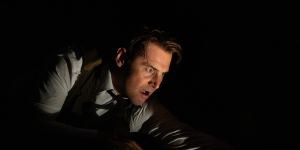
The Woman in Black is the second-longest-running play in London.Justin Nicholas
It really couldn’t be more foreboding:the house was built on a spit of land protruding from damp and drear fens,but high tide submerges the road to it,cutting off all escape,and sudden sea frets – impenetrable fogs that roll in from the ocean unexpectedly – disorientate and mislead anyone caught in them.
As Kipps works,he sees a mysterious woman in black – a ghost,surely. Only as he uncovers her tragic backstory does he realise,too late,that the woman in black is a dreadful portent,presaging a doom none can escape.
The play works in a meta-theatrical twist. An older Kipps (John Waters) hires a professional actor (MacPherson) to help re-enact his story:with the actor playing Kipps,and Kipps himself playing all other roles.
As you’d expect from these two veterans of stage and screen,the acting is secure,and certainly better than what critics thought about the performances in 2.22.

As you’d expect from these two veterans of stage and screen,the acting is secure.Justin Nicholas
It’s diverting to watch Waters pretending to be a terrible actor,or leaping into cameos as taciturn Yorkshire locals,and MacPherson is solid on the road from rational observer to victim of malign forces from beyond the grave.
Director Robin Herford does have room to fine-tune timing and atmospherics as the national tour progresses,but I should note that I’ve now seenThe Woman in Black three times. It isn’t an ideal position from which to review horror,which can only have its intended effect on an (at least slightly) unsuspecting audience.
The show’s jump scares mightn’t work on me any more,though for anyone yet to experienceThe Woman in Black,it’s the most commercially successful theatrical ghost story for good reason. Seeing it once is highly recommended.
Reviewed by Cameron Woodhead
MUSIC
An Evening With Marlon Williams ★★★★★
Melbourne Recital Centre,June 18
Onto an unlit stage,in front of a projection of gently rippling water,Marlon Williams arrives. He is nothing but a silhouette,his features lost to shadow. He sings,unaccompanied,in te reo Maori,the flutter of his expressive hands and the stamp of his feet against the stage emerging obscurely from the darkness.

Marlon Williams performs at the Melbourne Recital Centre on June 18,2024.©Martin Philbey
Over the next 25 minutes,as Williams performs a selection of his most elegiac songs – first at the piano,and then on an acoustic guitar – the stage lights remain stubbornly dim.
The effect is one of isolation (it’s no coincidence that the idea for this solo show was conceived during the 2020 lockdowns) but also functions as a kind of clarifying gesture:there is nothing to distract from the sheer loveliness of his voice. The sense of distance invoked through this stagecraft is subtle but crucial:when the stage lights finally bloom,lighting his face properly,it feels like a revelation.
The performance consists of three loosely thematic strands. The “insular sad-boy hoodie set” (his words) is the first. This gives way,post-interval,to a louche costume change and a vibe shift:a selection of more upbeat songs,performed karaoke-style over a pre-recorded backing track,and accompanied by magnetically weird dance moves,as well as crowd favourites from his back-catalogue likeDevil’s Daughter and I Wonder Why.

Even Marlon Williams’ most upbeat songs tend to be about feeling lost or displaced.Martin Philbey
The third strand shows him at his most vulnerable. Over the past few years,he has been introducing an increasing number of te reo Maori songs into his sets – for this performance,perhaps a quarter of the songs are either covers of traditional Maori ballads or contemporary works in te reo written by Williams and his collaborators. These songs are clearly important to him,yet he tends to present them in an almost apologetic way,as though he is not entirely certain the audience will respond to them positively. He needn’t worry:they will,and do.
Williams is primarily interested in loneliness – even his most upbeat songs tend to be about feeling lost or displaced or uncertain whether love is possible.
While it’s a pleasure to see these songs performed with a full band,there’s something about the spareness of a solo show that pulls them into focus,makes them even more resonant. It’s a gifted musician who can start a show in darkness and then soar so beautifully towards the light.
Reviewed by Nadia Bailey
THEATRE
When Night Comes ★★★
Broad Encounters,The Austral,until August 3
Immersive theatre has become something of a cult in Melbourne,andWhen Night Comes has fun running with the theme. Before you’re inducted into the show’s mysteries,you’ll get a black cowl and a gold mask to wear,and a senior cultist will squirt drops of an unnamed substance onto your tongue.
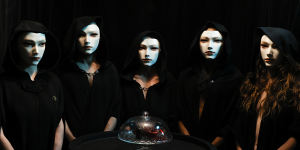
When the Night Comes offers up an evening of immersive theatre.Jeff Busby
Attendees should expect things to get freaky in this adults-only adventure. Broad Encounters has established the best sort of cult – the kind that serves cocktails – and its adherents follow the tenets of pleasure.
I must be cautious in what I reveal. A cult is still a cult and it’s not worth my life to betray its secrets to the unenlightened.
Perhaps you imagine some hedonistic fever-dream,a delirium of Wildean aesthetes and sensual satyrs,of light-blinded seers and doyens of exotic perfume or aquatic opera? Some sort of ecstatic ritual,indeed,drawing upon all the senses to seize the night? You might think that. I couldn’t possibly comment.
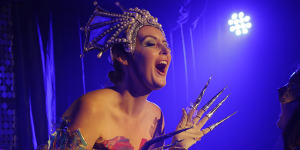
When the Night Comes distils individual acts of variety performance – cabaret,performance art,magic,burlesque – into one intoxicating hour.Jeff Busby
I can tell you that the show’s sold out for three weeks and extended its season,and that if you enjoyed Broad Encounters’ previous work –A Midnight Visit,a Gothic homage to the writings of Edgar Allan Poe,andLove Lust Lost,an immersive,Jules Verne-like undersea odyssey – you’ll like this too.
It might not have the budget of Malthouse Theatre’sBecause the Night orHour of the Wolf,but Broad Encounters is popular for good reason.
Here it distils individual acts of variety performance – cabaret,performance art,magic,burlesque – into one intoxicating hour. Acts introduce some memorably bizarre characters,who (like the cast of Teatro de los Sentidos’The Echo of the Shadow) encourage the audience to engage all five senses.
You’ll be guided from locale to locale,rather than wandering freestyle through a performance labyrinth. It’s closer to lightly interactive promenade theatre than full choose-your-own-adventure.
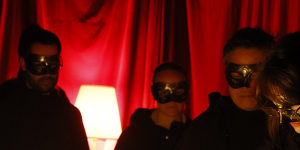
When the Night Comes.Jeff Busby
On balance,that’s a canny choice. You lose some agency,but you also don’t miss anything due to bad luck or incompetence (or spending too much time in the adult ball pit) eliminating all risk of FOMO. And the piece is slicker and more cohesive thanLove Lust Lost,while remaining imaginatively designed and performed.
If you’d like to join the cult of brief and boozy weird art experiences,sessions are available to fit neatly on either side of dining out,and anyone wanting to paint the town red should considerWhen Night Comes an excellent party-starter.
Reviewed by Cameron Woodhead
MUSIC
Shouse:Communitas ★★★★
Rising festival,St Paul’s Cathedral,June 15
As modern life makes us more isolated,the joy of singing with others – whether in pub choirs,sea-shanty gatherings or “musicals”-themed club nights – shines through as a beacon of communal joy.
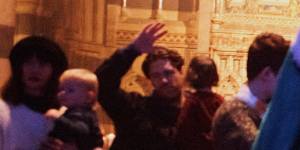
At Shouse:Communitas,the audience was part of the performance itself.Mandy Wu
In these environments,it doesn’t matter if your warble makes cats blush,and Shouse’s Communitas proves that when we all sing together,beautiful things happen.
Anyone passing by St Paul’s Cathedral would have been amazed by the immense lines outside on Saturday night. Had the Anglicans secured an exciting celebrity preacher? In a way,yes,becauseCommunitas was a glorious expression of the love,music and togetherness that make up the best parts of religion.
Shouse are a weirdo house electronic duo consisting of Jack Madin and Ed Service who rose to fame in 2021 with their song,Love Tonight:a song,sung by a thrown-together choir of friends,which sounded almost church-like in its evocation of love despite the thumping drum machines.
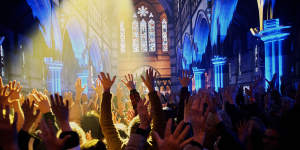
If only the cathedral could bottle this feeling,they’d have full congregations for another century.Mandy Wu
Once David Guetta remixed it,it climbed dance charts internationally and even scored a No.1 in Belgium.
On Saturday,Shouse didn’t play their hit,and although most bands would be despised for ignoring the entirety of their known catalogue,the crowd adored it.
St Paul’s is majestically lit as we enter,and the sound of all conceivable horns,strings and percussion rises to the distant vaulted ceilings from 60 or so musicians all playing long,droning notes together.
Once the crowd of hundreds has packed in,our white-clad maestros signal and all is quiet. Then the church organ begins alone and the masses of punters are all directed in the singing of single exhalating notes.
In an almost paganistic ritual,we circle the centre of the church,tapping each other’s backs in time. Eventually,our leaders in the centre urge us to sing “Ah,communitas”,and I get it;there is a spellbinding sense of convergence here.
Singing simple lyrics such as “I will run to you again” and “I can feel it rising”,we repeat simple dance moves and lyrics as we make our way through the cathedral. Our two maestros,the core members of Shouse,conduct the musicians and crowds exceptionally well,raising and lowering the volume and energy of the music and movement so that some lyrics rise above others in sublime moments of ebb and crescendo.
Although I came alone,I truly felt part of it all. It was like no other event I’ve been to (although there was a Polyphonic Spree vibe to the sense of massed joy). If only the cathedral could bottle this feeling,they’d have full congregations for another century.
Reviewed by Andrew McClelland
THEATRE
Cadela Forca Trilogy Chapter 1:The Bride and the Goodnight Cinderella ★★★★
Rising festival,Malthouse Theatre,until June 15
(in English,Bitch Power Trilogy) begins with the opening stanzas of Dante’sInferno. The lines that linger in the mind aren’t the most famous;they’re the ones in which the poet describes not remembering how he arrived in a “dark wood” before his descent into hell:
How I entered there I cannot truly say,
I had become so sleepy at the moment
when I first strayed,leaving the path of truth.
It sets up a disquieting resonance as inevitably,if a bit unfairly,the audience comes to this piece forewarned by media coverage (not to mention content warnings) about a pivotal scene.

Cadela Forca Trilogy translates to Bitch Power Trilogy.Christope Raynaud
We know Brazilian director,playwright and actor Carolina Bianchi will self-administer a date rape drug known in her homeland as “Goodnight Cinderella”. We know she will fall unconscious. We know she’ll be penetrated vaginally by a camera while she’s out of it.
All of which is misleading – not because these events don’t happen,but because the most extreme moments in Bianchi’s performance art are essential to a profoundly considered response to the most extreme forms of violence against women.
In the first half,Bianchi delivers an erudite performance lecture that roves from a notorious tale of femicide in Boccaccio’sDecameron to the scourge of gendered violence in Latin America. Coiled within it is the story of the show’s creative development.
Initially,Bianchi intended to resurrect Italian performance artist Pippa Bacca,who was raped and murdered near Istanbul in 2008,while hitchhiking from Milan to Jerusalem dressed as a bride. But Bacca’s fate reverberates. A silent chorus of other slain women (including well-known performance artist Ana Mendieta) invite the artist’s attention,and as the drug takes effect,Bianchi becomes disinhibited.
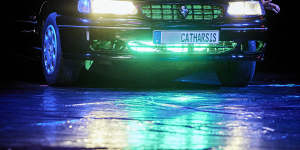
Cadela Forca:Just don’t call it therapy.Christophe Raynaud de Lage
There’s woozy karaoke to Brazilian pop. Bianchi confesses that she despises Bacca’s artistic choices. Her intellectual distance leans into poetic musings on the struggle to find a performance style fit to address her own rape,of which she has no recollection. (Goodnight Cinderella was involved.)
Bianchi is as ingenious as Philomela from ancient Greek myth in finding a way to speak to abject violation. For Philomela,whose tongue was cut out by her rapist,she wove her story into a tapestry;for Bianchi,radical performance art fills the void where memory should be.
Just don’t call it therapy. Bianchi doesn’t believe rape trauma can be “healed”,nor does she think taking drugs on stage is brave,and she’s got zero tolerance for easy platitudes or false comfort or emotional dishonesty.
Bianchi’s real solace lies in making uncompromising art,and the dream play that unfurls once she’s nodded off – a walk on the Brazilian wild side featuring nightmarish re-enactment – is guided by a recorded monologue that finds beauty in making darkness conscious.
Some stylised ensemble performance does look undercooked,especially in comparison to the intellectual and literary sophistication of Bianchi’s lecture. But it remains an impressive,forceful and creatively intelligent performance,interrogating the problem of violent misogyny in a way you won’t forget.
Reviewed by Cameron Woodhead
If you or anyone you know needs support,you can contact the National Sexual Assault,Domestic and Family Violence Counselling Service on (1800 737 732), 131 114,or 1300 224 636.
The Booklist is a weekly newsletter for book lovers from books editor Jason Steger..
